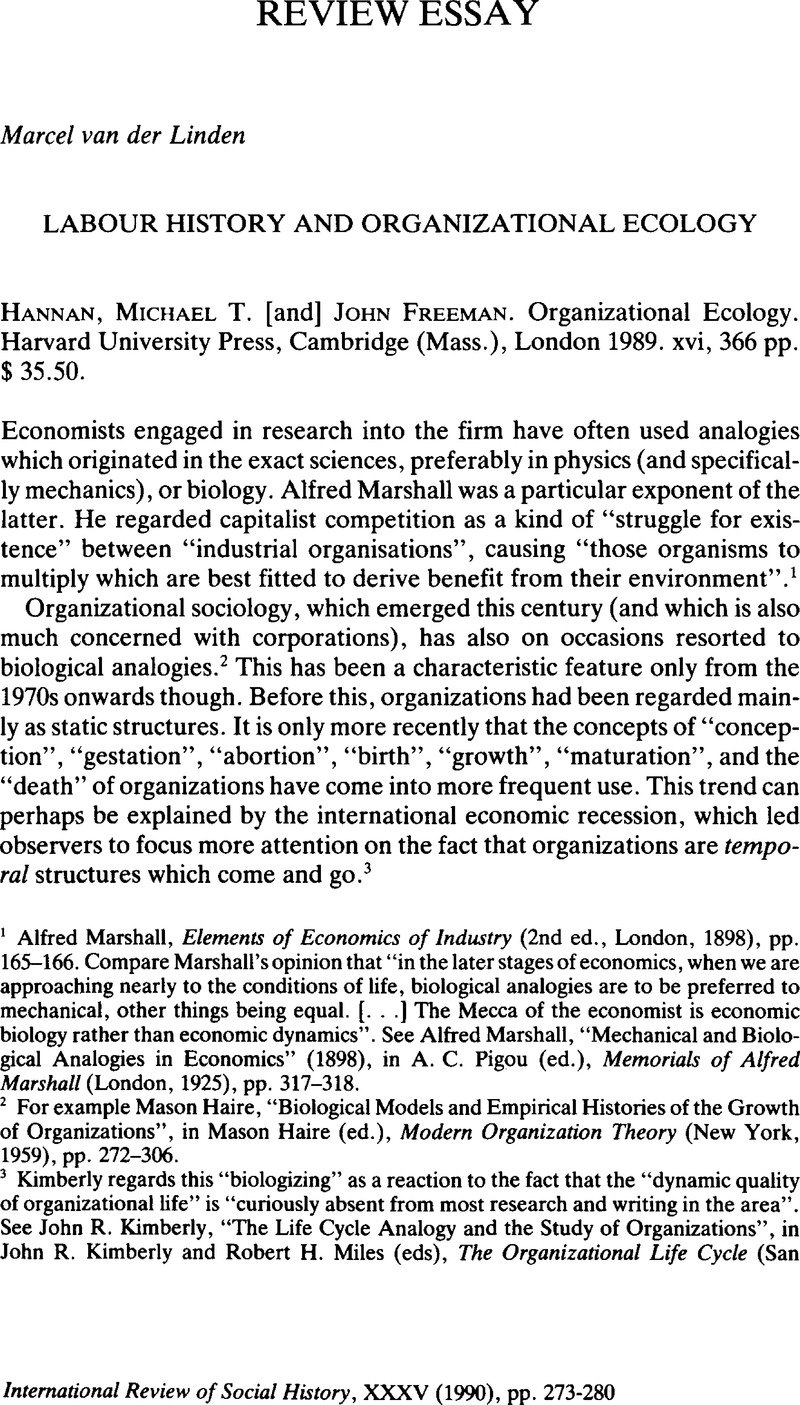No CrossRef data available.
Article contents
Labour History and Organizational Ecology
Published online by Cambridge University Press: 18 December 2008
Abstract

- Type
- Review Essay
- Information
- Copyright
- Copyright © Internationaal Instituut voor Sociale Geschiedenis 1990
References
1 Marshall, Alfred, Elements of Economics of Industry (2nd ed., London, 1898), pp. 165–166Google Scholar. Compare Marshall's opinion that “in the later stages of economics, when we are approaching nearly to the conditions of life, biological analogies are to be preferred to mechanical, other things being equal. […] The Mecca of the economist is economic biology rather than economic dynamics”. See Marshall, Alfred, “Mechanical and Biological Analogies in Economics” (1898), in Pigou, A. C. (ed.), Memorials of Alfred Marshall (London, 1925), pp. 317–318.Google Scholar
2 For example Haire, Mason, “Biological Models and Empirical Histories of the Growth of Organizations”, in Haire, Mason (ed.), Modern Organization Theory (New York, 1959), pp. 272–306.Google Scholar
3 Kimberly regards this “biologizing” as a reaction to the fact that the “dynamic quality of organizational life” is “curiously absent from most research and writing in the area”. See Kimberly, John R., “The Life Cycle Analogy and the Study of Organizations”, in Kimberly, John R. and Miles, Robert H. (eds), The Organizational Life Cycle (San Francisco, 1980), p. 3.Google Scholar
4 Surveys of this “organizational ecology” are given in Carroll, Glenn R., “Organizational Ecology”, Annual Review of Sociology, 10 (1984), pp. 71–93CrossRefGoogle Scholar, and in Wholey, Douglas R. and Brittain, Jack W., “Organizational Ecology: Findings and Implications”, Academy of Management Review, 11 (1986), pp. 513–533.CrossRefGoogle Scholar
5 Freeman, John and Brittain, Jack, “Union Merger Processes and Industrial Environments”, Industrial Relations, 16 (1977), pp. 173–185Google Scholar; Freeman, John, Carroll, Glenn R. and Hannan, Michael T., “The Liability of Newness: Age Dependence in Organizational Death Rates”, American Sociological Review, 48 (1983), pp. 692–710CrossRefGoogle Scholar; Langten, Nancy, “Mortality of Unions in the Service Sector” (Ph.D., Stanford University, 1984)Google Scholar; Hannan, Michael T. en Freeman, John, “The Ecology of Organizational Founding: American Labor Unions, 1835–1985”, American Journal of Sociology, 92 (1987), pp. 910–943CrossRefGoogle Scholar; Hannan, Michael T. and Freeman, John, “The Ecology of Organizational Mortality: American Labor Unions, 1836–1985”, American Journal of Sociology, 94 (1988), pp. 25–52CrossRefGoogle Scholar; Hannan, Michael T., “Age Dependence in the Mortality of National Labor Unions: Comparisons of Parametric Models”, Journal of Mathematical Sociology, 14 (1988), pp. 1–30CrossRefGoogle Scholar; Carroll, Glenn R. and Huo, Yangchung Paul, “Organizational and Electoral Paradoxes of the Knights of Labor”, in Carroll, Glenn R. (ed.), Ecological Models of Organizations (Cambridge, MA, 1988), pp. 175–193.Google Scholar
6 Stinchcombe, Arthur L., “Social Structure and Organizations”, in March, James G. (ed.), Handbook of Organizations (4th ed., Chicago, 1972), pp. 153–168.Google Scholar
7 This does not exclude the possibility that organizations can perform different sets of activities, in parallel or sequentially. “[L]abor unions gear up for organizing drives or for waves of strikes and then return to more placid bread-and-butter collective bargaining. […] Does this mean that these organizations have somehow escaped inertial tendencies? We think not […]. These organizations have multiple routines; they shift from one routine (or set of routines) to another in a fairly mechanical fashion. We think that organizations have high inertia both in the sets of routines employed and in the set of rules used to switch between routines” [75–76].
8 Stinchcombe, , “Social Structure and Organizations”, pp. 148–150.Google Scholar
9 Hannan and Freeman think, for instance, that “it is unwise to assume that selection processes in organizational populations strongly favor efficiency” [37].
10 For another interpretation see Aldrich, Howard E., Organizations and Environments (Englewood Cliffs, NJ, 1979).Google Scholar
11 For an extensive, if not always reasonable, critique see Young, Ruth C., ‘Is Population Ecology a Useful Paradigm for the Study of Organizations?”, American Journal of Sociology, 94 (1988), pp. 1–24.CrossRefGoogle Scholar
12 Van de Ven, Andrew H., “Organizations and Environments”, Administrative Science Quarterly, 24 (1979), pp. 324–325.Google Scholar
13 Bohm, David, Wholeness and the Implicate Order (London, 1981), p. 68.Google Scholar
14 Perrow, Charles, Complex Organizations. A Critical Essay (2nd ed., Glenview, IL, 1979), p. 243.Google Scholar




